Have you ever heard of kanuchi soup? It’s a traditional recipe from the Cherokee people that is easy to make and also very nutritious.
This sweet and nutty soup is made from hickory nuts. The Cherokee people used to pick up the fallen nuts, crush them, and make balls out of this paste. They would store these balls for later use, and this would be one of their primary food sources during the winter.
Kanuchi soup was an essential part of the winter diet for the Cherokee people because of its nutritional benefits. It is a great source of healthy fats, protein, and complex carbs from nuts. It is also a high source of vitamin E—a natural antioxidant that helps our immune system.
Taking into consideration everything that is going on in the world right now, adding this rich soup to your pantry is something you might want to do. It is not only tasty and nutritious but it also has a long shelf life if stored correctly.
How To Make Kanuchi Soup
This traditional Cherokee recipe requires very few ingredients. Hickory nuts are the main ingredient, and you can get them for free if you are able to forage them in your area.
⇒ The Berry That Is Illegal To Grow, But Perfectly Fine To Forage
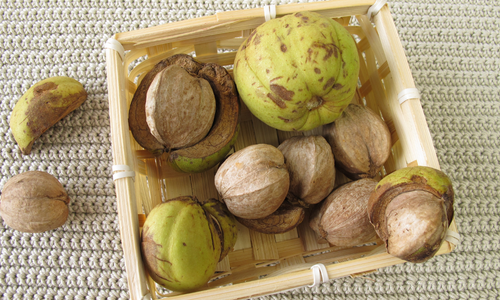
At harvest time, they fall from the tree by themselves. They usually start falling in October. However, if you do not have access to them, you can use a mix of pecans and walnuts and get a similar result.
What you need:
- 1 lb. hickory nuts, peeled and without hard shells. You can also use a 50–50 mix of walnuts and pecans.
- Water
- Salt
- Mortar and pestle or food processor
- Strainer
- Cooking pot
How To Prepare The Hickory Balls
The first step is making a paste out of the hickory nuts. Traditionally, the Cherokees used a “kanon” to mash the nuts, but I am going to use a mortar and pestle.
Related: The Native American Foods That Cherokees Ate During Hard Times
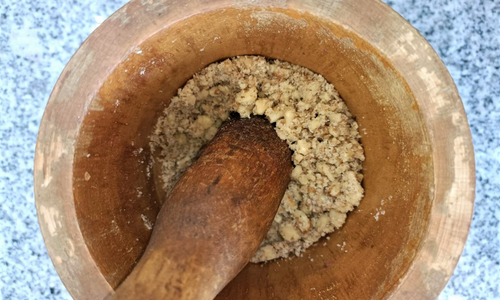
The texture of the ground nuts should look like the one in the picture. If you do not have a mortar, use a food processor for this step.
Once the hickory nuts have turned into a paste, you can start making the balls for later use. Use your hands, and start forming balls. I made five of these balls, and they weighed around four ounces each.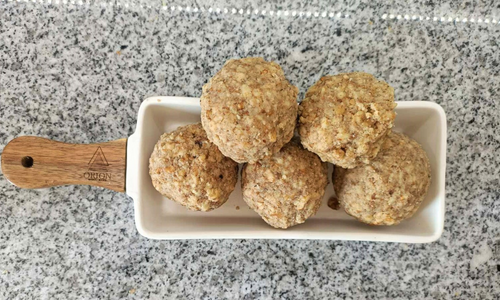
For the kanuchi soup, I am only using one ball and preserving the rest for later.
Making Kanuchi Soup
In a large pot, add 4 cups of water, and turn the heat on. When the water starts boiling, take the hickory ball, break it up, and drop it into the pot. Let the soup simmer for about 30 to 45 minutes.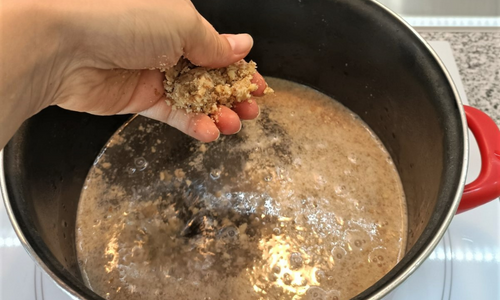
Run the soup through a strainer or a cheesecloth.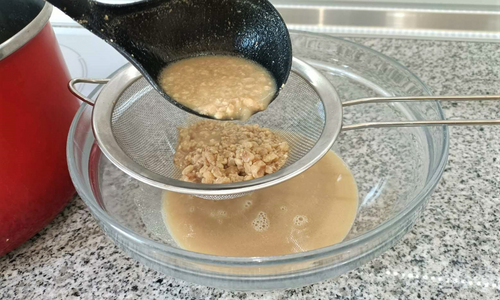
Return the liquid to the pot, and continue to simmer for another 20 minutes, until it begins to thicken.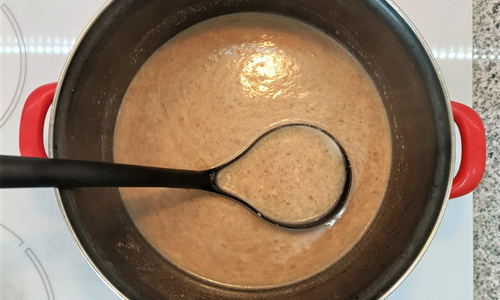
You can eat this soup what its own, or you can also add it to cooked rice together with some maple syrup.
How To Preserve Kanuchi
There are two ways you can preserve kanuchi. One is to vacuum seal the hickory balls. Make sure you keep them out of sunlight, in a cool, dark place. If stored correctly, they stay fresh and keep their flavor for up to six months.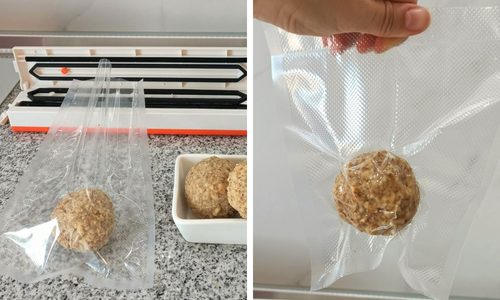
Another way to preserve this is to can the soup. During the winter, we definitely need some extra easy-to-prepare foods.
Canned homemade food is one of the healthiest ways to preserve good food that will nourish your body. If canned in the correct manner, this soup can be kept for years in your pantry or root cellar.
If you don’t have a root cellar, here you will find different types of root cellars that you can easily add to your homestead. From full sized traditional root cellars to small barrel or trash can root cellars, there’s surely something here that fits your needs.
Here is what you need:
- Cooking pot
- Jars
- Parchment paper
- Rubber bands
Instructions:
My mother didn’t have a canner but used a simple way of home canning. I watched her do this year after year, and now I do it myself. It is fast and efficient, and you cannot make mistakes.
Take some clean jars, and fill them with hot soup. Make sure to wipe the rims so there is no soup or other food particles.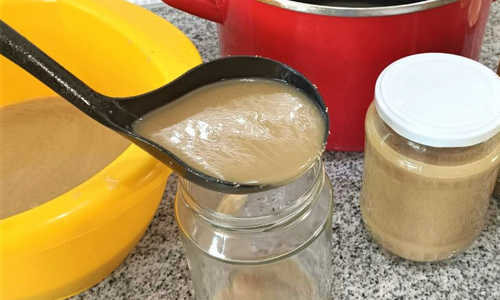
I like to run a wet cloth on the rims and then wipe them with a dry cloth just to make sure everything is perfectly clean. After this step, carefully close the jars.
Take some parchment paper, and roll it around the jars. This will prevent the jars from breaking. Secure the parchment paper with rubber bands.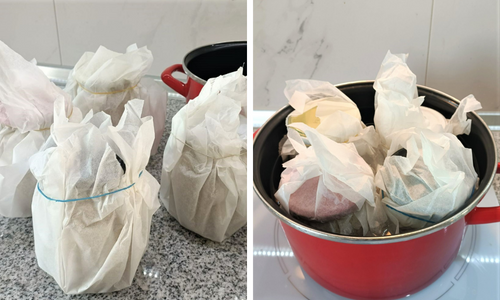
Once you have all the jars wrapped in parchment paper, place them in the cooking pot and add water. I am practicing the 2/3 water 1/3 free jar method. Turn on the heat and let it simmer for 25 minutes.
How To Store The Kanuchi Soup
If the canning process goes well, you will notice a small dent on the jar lid. Keep the jars in a cool, dark place, away from heat and direct sunlight.
I like keeping my jars in my root cellar; that way I am sure there will be no temperature swings, and the canned food stays good for years.
The Cherokee people certainly understood the importance of growing their own crops, foraging and food preservation. They relied on wild plants and hunting for survival.
Nuts were especially important for the Cherokees. After the fall harvest, they would store chestnuts, butternuts, hickory and pecan nuts for months, regularly checking for signs of spoilage, to help get them trough the tough winter.
Let me know in the comments what other traditionally Cherokee recipes you heard of and would like to learn to prepare yourselves.

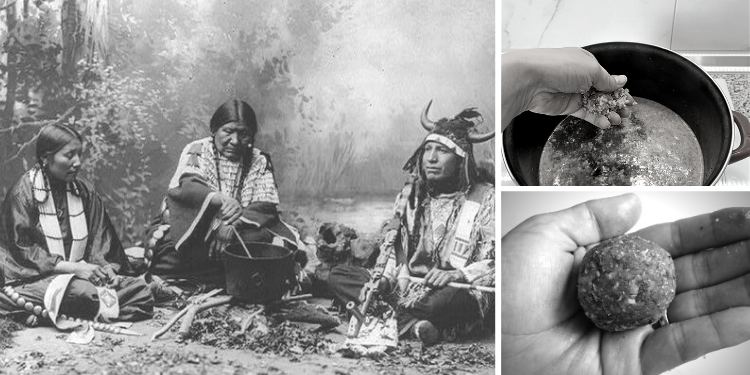




















M6 grandfather was chief grand Cherokee. We made this dish often and he added nutmeg for flavors.
Beware it freeze drys like poop
This looks appetizing, and I bet it would make a nice filing for wonderfully, surprising hors-d’oeuvres at one’s next party.
Yeah. No offense but, This Looks gross. Id rather eat a can of black beans and a packet of ramen noodles. Or some home made granola. Both will last years in storage and taste better (I’m sure) than these here “cherokee balls”. But hey…to each his own.
I think the key point is the ability to forage for food. But hey, maybe you’ll luck out and find a ramen noodle tree.
Don’t knock it ‘til you try it!
I understand ur trepidation but Ramen noodles are one of the worst foods you can eat. But again to each his own. Gonna at least ry this first.?
Do you have any idea how filthy and nasty top Raman is? Do you know where and how they make it? Do you know what’s in it will out right kill you?
Forget the cosmetics, at least this stuff is healthy
You can literally starve to death on “ramen noodles.”
You opened your black beans only to find mold has grown on them and your ramen flavor packet fell out at your last eating location which is miles away. Solve to prevent starvation.
Hello, can you add dried herbs or other seasonings into the ground nut mixture when making the balls? I’m thinking to make a more flavorful soup ….???
Kid – I don’t see why not! It says one can use chestnuts, instead of pecans or hickory or black walnuts. We enjoy chestnut soup as a first course on Christmas.
I am sure you can. Won’t hurt to try.
Also… another thought … what do you use the strained out solids for – after making the soup? Are there any nutrients left in them?
Nuts have lots of nutrients, and it looks easy to make.
I’ll try to make to store…
Seems like this method would work for any of the hard tree nuts. I’m guessing the grinding process to bring out the oils is the most important part, otherwise you could just make a soup directly from the whole nutmeats. Since storing nuts whole and unshelled is a generally longer lasting potential storage method, I’d assume they gathered and stored the nuts themselves as they ripened throughout the fall, then made the balls at the end of fall, before they could turn rancid from the oils and when the cold weather could aid their storage. Keep in mind this is conjecture on my part based on the seasonal hickory nut harvest. Unlike many “nut flour” methods of preservation that dry the nuts out, these soup balls would take full advantage of the oils the nuts can provide, which is perfect for winter nutrition. I’m now considering trying this soup method with both my pecan harvest and my Filbert harvest. Might try almonds as well, although those would have to be bought from the store.
wondering about other nut varieties ?????
You probably can…the biggest thing for this recipe is the ability to forage for the nuts for free.
Try it. Remember, this is one recipe for nuts. Chestnuts work and make a good flour, as well. this is a base for nut candies, as well. niio
I would venture to guess (since no measurements are included) that the ratio of the mixture is. Enough water to form a paste and salt to taste, is that correct? Does the salt keep the nuts from turning rancid? When making the soup, can’t the nut solids be left in the mixture as they add bulk and therefor are not wasted.
I never saw where the salt was used.
Hi, I would like to know about what to do with the leftover nut solids as well. I love nuts and anything with nuts in it so I wouldn’t want to waste them. Thanks for such great information you provide on this site.
Interesting but I don’t have any hickory trees around me. I do have lots of oak trees what can you do with acorns?
Have to boil the acorns for a while to soften the strong tannin flavor, which is very bitter. But same method otherwise. The paste was/ is used for filling in breads as well as eaten directly. Give it a try and experiment with your favorite spices. Once the paste is prepared it can be frozen or dried in an oven or out on a picnic table in the sun on a dry and windy day. Don’t let the squirrels have all the fun…
Tannins in acorns are poisonus. Boil acornd several times until the water is clear. The tannins are tannic acid as in tanning animal hides.
Gambel oak acorns do not need leaching. No tannins.
Same here. Lots of acorns. Let’s just try it! Gamble oaks here. Love the flavor they give to coffee .
We have lots and lots of hickory trees on our place, and have tried cracking hickory nuts. This article says not a word about how to shell hickory nuts. We have tried nut crackers, hammers, all sorts of things. We could hardly get into them at all! And when you smash them with a hammer, it is nearly impossible to separate the dangerous shell bits from the nut meat! We gave up years ago, because we really could not find any doable way to shell the things! Why is there not a word in this article on how to shell the hickory nuts in some usable way? Please add that here.
I use a bench vise; it’s slow because I can crack only one at a time, but I can crack black walnuts and Brazil nuts as well. It makes a good indoor project.
I really like this article.
I took some Cherokee language classes in Tahlequah, OK some years ago. Each night about half way through the class we’d take a break. The Cherokee ladies in the class would prepare a “snack” which was actually more like very nice meal. One night they shared kanuchi. They told us that wasn’t familiar with it what it was and how it was made…very labor intensive but well worth the effort. Like I said its been some years ago so I don’t remember all they told us. I wish I had taken notes. Seems like I do remember them saying that during the straining process they used a cheesecloth material to separate the hard shell pieces from the soup.
Just my opinion but I thought it was very good.
I used to have two hickory trees on my property and we harvested the nuts and used them. I haven’t done the soup before but used them other ways. My first recommendation is to eat one and see how they taste to you. You may like the flavor or you may not. The best way to preserve any nut is to freeze it. Nuts will go rancid eventually if stored on a shelf in the pantry. Acorns can be used but you need to soak them for a long time to leech out some of the tannin.Once you have leeched out the tannin then dry them on a rack or in a dehydrator. After drying you can grate them into a powder that you can use as a substitute for flour or a base for soup. Pecans, hazelnuts, black walnuts, cashews, etc. can be used to make many different flavors of soup. Pick the one you like the flavor of the best. My favorite is coconuts.
California indians peel then crack acorns. Let them leach in the wet sand along a flowing stream for a few days. Then boil till the broth is getting slightly thickened. It tastes like unseasoned pinto beans. I’d think salt would improve it.
Where I live in high mountain desert our only nuts are pinion or pine nuts. Here they are used mainly 2 ways. One is roasted in a frying pan and lightly sa l ted. Crack and eat as a snack.
The second way is in deer stew. Boil deer neck or backbones. Add roasted dried corn kernels, in the shell pine nuts, wild garliky onions, wild celery, and if desired either fire roasted green chile peeled and cut up or dried red chile crushed and added. Some crushed coriander seeds are added with red chile or chopped green cilantro with green chile. Chili, cilantro or coriander are optional. Boil till the broth is a rich bone broth and the shells of the pinion are softened to crack with your teeth as you eat the soup.
Hey, Clergy Lady, This can be done with pine nuts, too. People would add sweetener and some spices to make candy. niio
A homestead today is a place of comfort, hard work, and learning, with internet access to read articles like this, learn, and comment, if you will. A homestead tomorrow may still have all those things yet perhaps not internet or other nonessentials. So, learning how the Cherokee not only made-do but thrived with a tasty, healthy, hot meal, free from Mother Nature, will surely not be lost on turd-bird when his beans and Ramen noodles run out, or when he’s frail and sick from no essential nutrients. That bowl of thick, hot soup would look like the grand buffet of any restaurant. Thanks for sharing about the bench vise for cracking walnuts and the reminder that straining will handle shell chips. The herb garden was something that the Cherokee didn’t have, so I’m sure any and all varieties would add kick and flavor (I’m thinking jalapeños, maybe fresh tomato when served).
Our community pantry gave out lots of almonds, walnuts, pecans, hazel nuts, and pistachios in early summer time. I have a lot left that I’d hate to have go rancid. I may try soups and storage both.
Very interesting. I grew up eating hickory nuts and black walnuts. Both were used for pies and cakes or just snacks by themselves. Loved them both. Still do. Never tried kanuchi but would love to sample it. For those asking about shelling the hickory nuts, first they don’t mature or fall over a long period of time. They fall off the tree and continue for a few weeks until they all have fallen. The period is a relatively short one once they begin to fall. The first task is to hull the outer shell of the nut which can be easily accomplished with a hammer or even a rock the size of your hand. Some nuts may even hull themself after hitting the ground or after the hulls begin to dry out. When dry, they may even be hulled by hand.
As far as cracking the hard inner shell of the nut, this might best be done with a hammer although it can also be done by a rock. There are a myriad of nut-cracking devices one can purchase through the Internet for those not so handy with a hammer. (or rock!). The debate continues as to which is the best way to turn the nut for cracking it. Two options exist. Laying it flat or turning it up on its edge. Either way will work. Try them both and see which you prefer and keep at it. The main thing to remember is that it is best to hold the nut with your fingers while cracking it so pieces don’t go flying up into your eye or across the room. Simply smashing the hard shell will send pieces flying in all directions plus it will ruin your chances of retrieving larger pieces of the nut. Don’t worry about hitting your fingers. That’s part of the learning curve. After a few times you will quickly learn how to hold the nut properly thus reducing or minimizing such an event. Once the nuts are cracked, the inner nut meat can be removed by any number of small devices. When growing up it was proper to use a horse-shoe nail for extracting the nut meat. I learned later it really didn’t matter so much and have been using a small pocket knife blade effectively for 60 years now. They also make those “nut getter outers” that also work as well as a pocket knife.
For any who are so unfortunate to have never eaten hickory nuts, I recommend first applying them to the top of a pie as one would do in making a pecan pie. Delicious!
I, too, would like to see the answer about what is done with the hickory nut pieces that are seived out after straining. Surely these pieces are not discarded and were/could be used for something.
And I would also be greatly interested in how the Cherokees preserved the hickory balls throughout the winter months. This was not addressed in this article. I’m sure they didn’t have access to a freeze dryer or canning jars 200 plus years ago. Inquiring minds wish to know.
I’m thinking that the left over sieved nut meats could be dried and ground to a flour type consistency. By adding favorite herbs and spices you could make an unleavened “fry bread”.of sorts, or mix with corn meal, etc. My great, great Grandmother was Cherokee, and although I never knew her personally, from what I’ve been told, the Cherokee did not waste anything..
Are these hickory nuts? the same as macadamia nuts, kindly advice??
Nope. Hickory are related to pecans, but taste better. Macadamia can be used instead. niio
Hickory nuts might use the walnut method. Boiling the nuts til they soften. Once again- dry then proceed to clean! Just a Suggestion!
My Indian ancestors make Kanuchi from Chin nuts. Grandma squeezed the nuts by hand to make it.
This is all well and good as far as today’s canning goes but you never mentioned how the Cherokees managed to preserve as they obviously did not have canning jars and lids.
Our ancestors dried and smoked many foods. Rendered fat makes a good seal, too, if it can be kept in a cool place. I once wanted to save the juice from a baked ham to use for seasoning purposes in an upcoming meal (probably beans or gravy), and the glass jar I used as a container got lost in my refrigerator for months. When I discovered it I was amazed and happy that it was still good. It made the best gravy. The fat from the ham had risen to the top of the juice and congealed, making a nice healthy half inch seal. I even used the lower quarter inch of fat for my gravy and tossed that which was closest to the surface.
They dried it. niio
In Arizona the Apache Indians, and others, make a nutty, but slightly bitter, paste that I ate about 30 years ago while helping build a church at Canyon Day, AZ. Some didn’t like it, but none was wasted. Those of us who liked it ate our share, and the shares of those who didn’t like it. The Tohono O’Odham tribe was known as the Papago tribe until a few decades back. Their new name means Desert People, and Papago meant Bean Eaters. They make several dishes from the beans that they gather from the ground and lower branches of the desert trees. There’s not a lot of natural food on the Sonoran Desert lands of Arizona, and Sonora, Mexico, but they knew of them all and survived using them. They even knew of several medicinal plants. One that I will always remember is that when an elderly man could not urinate freely (Women?), the men would gather around a fire of dry Mesquite tree branches with him and administer a tea to him made from small strips of bark taken from the northern side of an Ocitillo cactus. They say they sit around with the patient 24/7 administering as much of the tea as possible for about three days, or until he seemed cured. At age 81, I realize I might need a strong diuretic and will try this if HCTZ fails me;
Are these hickory nuts the same as macadamia nuts?
The hickory nut itself is shaped a bit like a walnut. A macadamia nut is almost perfectly round. The hickory nut has more nutritional value than the macadamia nut.
Jeffers Bend is on the river in Hopkinsville KY. where the Cherokee walked AKA Trai of Tears. I shall use this when the school students come to the Bend for the day of Resource and Conservation classes. Thank you for the recipe and history lesson.
Chestnuts remain a good source of antioxidants, even after cooking. They’re rich in gallic acid and ellagic acid—two antioxidants that increase in concentration when cooked. Antioxidants and minerals like magnesium and potassium help reduce your risk of cardiovascular issues, such as heart disease or stroke. You want heart disease or stroke?
Eat stuff like ramen noodles! #7
I don’t understand why you would strain out the solids rather than consuming the entire product? Seems very wasteful especially if doing this for survival.
Maybe because as mentioned here, there were bits of shell in the nutmeat…
Possibly too time consuming to remove all of the shell bits.
Wish there was a way to erase the above post. At best now readers will have two articles about Kanuchi. Have a good day.